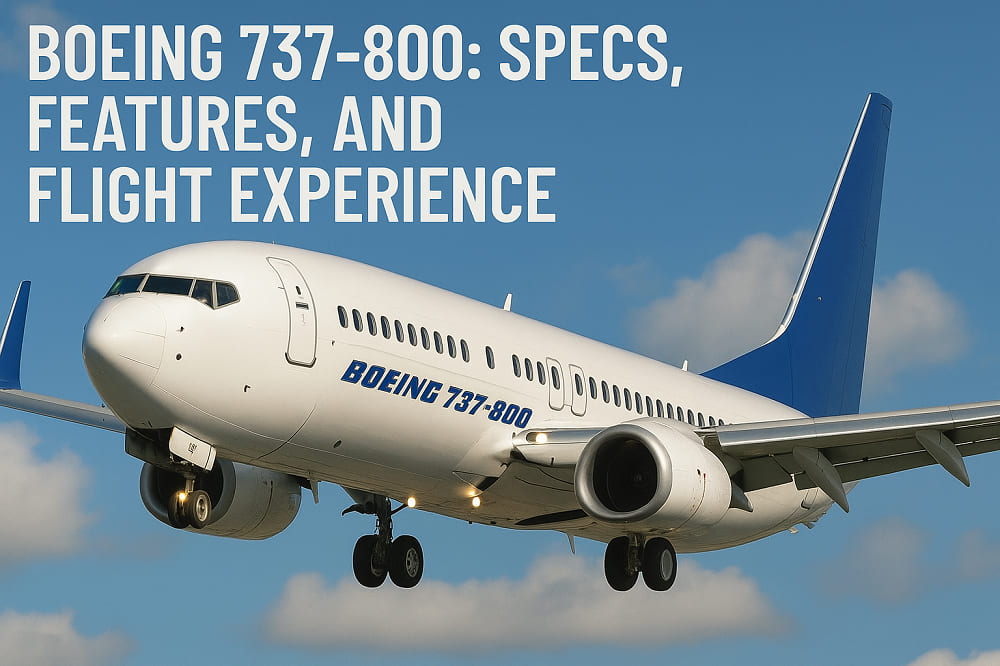Discover the remarkable Boeing 737-800, one of the most successful commercial aircraft ever built. This comprehensive guide explores its specifications, development history, and the features that have made it a preferred choice for airlines worldwide.
Overview of the Boeing 737-800
The Boeing 737-800 stands as a cornerstone of the renowned Boeing 737 family, representing a significant advancement in commercial aviation. This narrow-body aircraft, designed for short to medium-range flights, evolved from its predecessor, the 737-700, to meet growing market demands.
As part of the Next Generation (NG) series, the 737-800 exemplifies the perfect balance between operational efficiency and passenger capacity. Its versatility allows airlines to maximize revenue potential while maintaining the reliability that has become synonymous with the 737 family name.
History and Development of the Boeing 737-800
The early 1990s marked the beginning of the 737-800’s development as Boeing sought to enhance its successful 737 Classic series. Launched in September 1994, the aircraft incorporated cutting-edge technology while maintaining compatibility with existing 737 models, ensuring cost-effective pilot training for airlines.
- First rollout – June 1997
- Maiden flight – July 31, 1997
- Commercial service entry – April 1998 with Hapag-Lloyd Flug (now TUIfly)
- Initial target market – Growing low-cost carrier segment
- Design focus – Advanced technology and aerodynamic improvements
Key Milestones in Boeing 737-800 Production
| Year | Achievement |
|---|---|
| 1999 | Became best-selling version of Next Generation 737 family |
| 2006 | Surpassed 737-400 as most commonly used 737 model |
| 2007 | Delivery of 1,000th 737-800 |
| 2012 | Delivery of 5,000th Next Generation 737 (737-800 model) |
| 2021 | Over 4,000 737-800s delivered globally |
Specifications of the Boeing 737-800
The Boeing 737-800’s technical prowess combines efficiency with outstanding performance capabilities, making it a versatile choice for diverse route networks.
Technical Specifications and Dimensions
- Wingspan – 35.8 meters (117 feet 5 inches)
- Length – 39.5 meters (129 feet 6 inches)
- Height – 12.5 meters (41 feet)
- Maximum takeoff weight – 79,016 kg (174,200 lb)
- Operating empty weight – 41,413 kg (91,300 lb)
Engine and Performance Details
- Engines – Two CFM56-7B turbofan engines
- Thrust per engine – 27,300 pounds
- Maximum speed – Mach 0.82 (876 km/h)
- Cruising speed – Mach 0.79 (842 km/h)
- Range – 5,765 km (3,115 nmi)
- Service ceiling – 41,000 feet
- Takeoff runway requirement – 2,300 meters (7,500 feet)
Seating Capacity and Layout
| Configuration | Capacity | Layout |
|---|---|---|
| Two-class | 162 passengers (12 business + 150 economy) | 2-2 (business), 3-3 (economy) |
| Single-class | Up to 189 passengers | 3-3 throughout |
Features of the Boeing 737-800
The Boeing 737-800 represents a masterpiece of commercial aviation engineering, combining advanced technology with proven design elements. This Next-Generation (NG) aircraft delivers exceptional performance through its carefully crafted features that enhance efficiency, reliability, and passenger comfort.
- Wingspan – 34.32 meters with advanced winglets for reduced drag
- Length – 39.50 meters optimized for operational efficiency
- Cruise speed – Mach 0.79 (460 knots)
- Service ceiling – 41,000 feet
- Range – Up to 2,000 nautical miles
- Engine type – Two CFM56-7B turbofan engines producing 117 kN thrust each
Cockpit and Avionics
The 737-800’s cockpit exemplifies modern aviation technology with its two-pilot configuration, marking a significant advancement from the three-crew setup of its predecessor, the Boeing 727.
- Six large LCD displays for critical flight information
- Integrated Flight Management System (FMS)
- Advanced autopilot capabilities
- Weather radar system
- Traffic Collision Avoidance System (TCAS)
- Common type rating with other 737 NG variants
Passenger Comfort and Amenities
The Boeing 737-800’s cabin design prioritizes passenger comfort through innovative features and modern amenities. The signature Boeing Sky Interior creates an enhanced travel environment with:
- Sculpted sidewalls for increased spaciousness
- Larger window reveals for better views
- Customizable LED lighting system
- Enhanced overhead bin capacity
- Optional in-flight entertainment systems
- Available Wi-Fi connectivity
- AC power outlets at seats (airline-dependent)
Safety Features and Innovations
Safety stands as a cornerstone of the 737-800’s design, incorporating multiple advanced systems and redundancies:
- Enhanced Ground Proximity Warning System (EGPWS)
- Traffic Alert and Collision Avoidance System (TCAS)
- Damage-tolerant structural design
- Redundant hydraulic systems
- Backup electrical systems
- Continuous safety improvements based on operational feedback
Flight Experience on the Boeing 737-800
The Boeing 737-800 delivers a consistent and reliable flight experience, balancing efficiency with comfort on short to medium-haul routes. Its widespread adoption has made it a familiar sight at airports worldwide, offering passengers a sense of confidence through its proven track record.
Airlines Operating the Boeing 737-800
| Region | Major Operators |
|---|---|
| North America | American Airlines, United Airlines, Delta Air Lines, Southwest Airlines |
| Europe | Ryanair, Norwegian Air Shuttle, Turkish Airlines |
| Asia-Pacific | China Southern Airlines, Qantas |
Passenger Reviews and Feedback
Passenger experiences on the 737-800 vary based on airline configuration and service level. Common feedback includes:
- Positive aspects:
- Quiet cabin environment
- Improved overhead storage
- Reliable performance
- Areas of concern:
- Seat width in economy class
- Limited seat pitch on some carriers
- Compact lavatory size
- Variable entertainment options
Comparing the Boeing 737-800 with Other Aircraft
The Boeing 737-800 maintains a competitive position within its aircraft class, particularly when measured against its primary rival, the Airbus A320. While passenger opinions often favor the A320 for perceived comfort advantages, the comparison reveals interesting distinctions in both aircraft’s characteristics.
| Aspect | Boeing 737-800 | Airbus A320 |
|---|---|---|
| Passenger Comfort | Traditional design, variable comfort based on airline configuration | Generally preferred for comfort, wider cabin feel |
| Performance | Strong operational efficiency, reliable performance | Comparable efficiency, modern flight characteristics |
| Route Flexibility | Excellent balance of capacity and range | Similar capabilities, good network versatility |
While newer aircraft models like the 737 MAX and A320neo offer enhanced fuel efficiency and extended range capabilities, the 737-800 maintains its position as a dependable workhorse in many airline fleets. It’s worth noting that the actual passenger experience often depends more on individual airline configurations and maintenance standards rather than inherent aircraft design differences. This factor significantly influences comfort levels and overall flight satisfaction across both aircraft types.
Read more:
- Boeing 707: History, Features, and Impact on Aviation
- Boeing 777: Features, Specifications, and Insights
- Boeing 737 Max: Latest Updates and Safety Information
- Boeing 737-900: Specifications, Features, and Seat Map
- Boeing 717: Specifications, Features, and Flight Experience
- Boeing 767: Specifications, Features, and Insights
- Boeing 737-700: Features, Specifications, and Seat Map
- Boeing 787-9: Features, Specifications, and Insights
- Boeing 767-400: Specifications, Features, and Seat Maps
- Boeing 777-200: Specifications, Features, and Seat Map
- Boeing 747-400: Features, Specifications, and History
- Boeing 757-300: Specifications, Features, and Seat Map
- Boeing 737-900ER: Specifications, Features, and Seat Map

